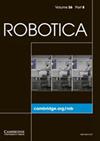基于新框架的自适应反步进控制器,用于踝关节康复球形并联机器人的动态解决方案
IF 2.7
4区 计算机科学
Q3 ROBOTICS
引用次数: 0
摘要
本研究基于新颖的建模框架,为 3-RRR 球形并联机械手(RSPM)的自主控制提供了一种基于模型的自适应方法。RSPM 是一种超约束并行机械装置,由于其精度和准确性,在踝关节康复等医疗程序中有着广泛的应用。然而,由于其固有的奇异性、肢体的耦合效应以及中间关节施加的冗余约束,为跟踪目的获取这些机构的完整显式动态模型一直是一个难题。本文提出了一种基于闭环矢量法(包括约束分析)的新算法,用于获取 RSPM 的解析运动学解。通过将约束运动学纳入动态模型,基于螺杆理论和机械手扭转代数方程的线性同质特性,在任务空间中建立了 RSPM 的无过约束版本 3-RCC 的综合显式动态解。基于所提出的计算框架,鲁棒自调整反步态控制(STBC)策略被应用于机器人,以克服外部干扰和时变不确定性的影响。此外,还提出了一种基于观测器的补偿(OBC)方法,用于在轨迹跟踪过程中处理踝关节的非线性滞后环。包括 STBC 和 OBC 在内的整个系统的闭环稳定性是通过 Lyapunov 方法从理论上实现的。所提出的方法通过不同场景下的实际协同模拟进行了验证。例如,在有外部干扰的情况下,STBC 的最大跟踪误差规范比滑动模式方法小 37.5%。本文章由计算机程序翻译,如有差异,请以英文原文为准。
Adaptive backstepping controller based on a novel framework for dynamic solution of an ankle rehabilitation spherical parallel robot
This research offers an adaptive model-based methodology for autonomous control of 3-RRR spherical parallel manipulator (RSPM) based on a novel modeling framework. RSPM is an overconstrained parallel mechanism that has a variety of applications in medical procedures such as ankle rehabilitation because of its precision and accuracy. However, obtaining a complete explicit dynamic model of these mechanisms for tracking purposes has been a problematic challenge due to their inherent singularities, coupling effects of the limbs, and redundant constraints imposed by the intermediate joints. This paper presents a novel algorithm to obtain the analytical kinematic solutions of RSPMs based on the closed-loop vector method, which includes constraint analysis. By incorporating constrained kinematics into the dynamic model, a comprehensive explicit dynamic solution of the non-overconstrained version 3-RCC of RSPM is developed in task space, based on screw theory and the linear homogeneous property of algebraic equations on the manipulator twist. Based on the proposed computational framework, a robust self-tuning backstepping control (STBC) strategy is applied to the robot to overcome the effect of external disturbances and time-varying uncertainties. Furthermore, an observer-based compensation (OBC) method is presented for dealing with the nonlinear hysteresis loops of the ankle during trajectory tracking purposes. The closed-loop stability of the whole system including STBC and OBC is theoretically performed by Lyapunov methods. The proposed methodologies are validated by realistic co-simulations in different scenarios. For instant, in the presence of external disturbances, the maximum tracking error norm of STBC is 37.5% less than the sliding mode approach.
求助全文
通过发布文献求助,成功后即可免费获取论文全文。
去求助
来源期刊

Robotica
工程技术-机器人学
CiteScore
4.50
自引率
22.20%
发文量
181
审稿时长
9.9 months
期刊介绍:
Robotica is a forum for the multidisciplinary subject of robotics and encourages developments, applications and research in this important field of automation and robotics with regard to industry, health, education and economic and social aspects of relevance. Coverage includes activities in hostile environments, applications in the service and manufacturing industries, biological robotics, dynamics and kinematics involved in robot design and uses, on-line robots, robot task planning, rehabilitation robotics, sensory perception, software in the widest sense, particularly in respect of programming languages and links with CAD/CAM systems, telerobotics and various other areas. In addition, interest is focused on various Artificial Intelligence topics of theoretical and practical interest.
 求助内容:
求助内容: 应助结果提醒方式:
应助结果提醒方式:


